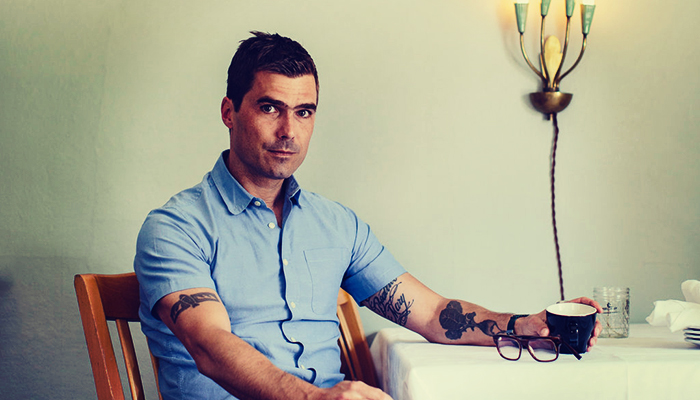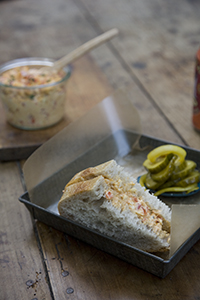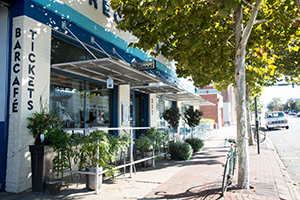
Anyone who has observed Hugh Acheson as a judge on Top Chef can attest the award-winning toque is not only a culinary powerhouse, but also a charming and witty force to be reckoned with. The Canadian-born chef started off as a dishwasher at the age of 15 before going on to train at a variety of well-known restaurants, including Quebec’s historic Café Henry Burger, where he learned French cuisine, wine and etiquette from chef Rob McDonald.
After working in sous chef and chef de cuisine roles in San Francisco, Acheson moved with his wife, Mary Koon, to her hometown of Athens, Georgia, where he opened his first restaurant, Five & Ten, in 2000. He has since gone on to open The National (and the now-shuttered Cinco y Diez) in Athens, Empire State South in Atlanta, and The Florence in Savannah. In between tending to all of these kitchens, Acheson has competed on season three of Top Chef Masters and served as a judge on seasons 9 through 12 of Top Chef, as well as Top Chef Duels.
His first cookbook, A New Turn in the South: Southern Flavors Reinvented For Your Kitchen, was awarded the 2012 James Beard Foundation award for best cookbook in the field of “American Cooking.” (Acheson was also a James Beard co-winner of “Best Chef: Southeast” in 2012.) Acheson’s second work, Pick a Pickle: 50 Recipes for Pickles, Relishes, and Fermented Snacks, came out last spring.
After leading a demo in cooking with fava beans at the 2015 Austin Food & Wine Festival, the father of six (two children and four restaurants) chatted with us about his latest projects — revamping the home economics curriculum in his local school district, releasing his third cookbook, The Broad Fork: Recipes for the Wide World of Vegetables and Fruits, and spreading the word that Southern cooking goes much farther than fried chicken and biscuits.
You started working in kitchens at a very young age. Did your love of food begin at home?
Yes, when I was 15, I started working after school in various restaurants. Not always great restaurants, but you learn something everywhere you are. It was just a job, really, but it flourished into what I really love. I wasn’t raised in much of a gastronomic household. There were little fits and spurts of goodness in the food, but I was pretty much raised by a single father, so we ate a lot of canned yellow wax beans and fish sticks. And I have three older sisters. We got by, but I wouldn’t say we were feasting on the real delicacies of life.
Has growing up in Canada been a big influence on the food you make?
It definitely has. I think the biggest thing that’s still very apparent in Canada, where I’m from in Ottawa and Montreal, is that the seasons really matter. I think seasonality became imprinted on my food and the style of food that I do very early. And that’s just so important in the world of ingredients — making sure you’re understanding what the seasons are bringing in. There’s abundance in this world all the time, but I think we really have a connection to food when we pick a tomato at its ripest point in time in August and wait eagerly for a local apple in October.
Do you get to return often to Canada to visit?
I do. My dad still lives there so I go up there and visit. Just north of Toronto, we have a family cottage where we spend some time each summer. And I try to get Montreal at least once each year, and Toronto and Quebec City. I spend a little time out west in Vancouver and Calgary. It’s great up there. I’ve lived down here for a long time but I still have a lot of love for Canada.
Are there any Canadian culinary traditions you wish the States would adopt?
Quebec has an amazing tradition of great cheeses. I think the States is getting so much better with artisanal cheese and supportive of smaller farmers and dairies doing great things. But they have a lot of great unpasteurized cheese in Quebec that you can’t buy pretty much anywhere else in North America because of restrictive health regulations.
How would you say you’ve seen Southern food culture change through the years?
You know, I got here 20 years ago and I didn’t know much about Southern food. But the beauty of Southern food is it has amazing depth to it. It’s documented and storied and it’s got history to it. It’s not always beautiful history — it’s a lot of harsh history. A lot of what we call Southern food was brought here on the backs of slaves. But I’ve learned to really respect the cadence of the agrarian environment in which we live and the Southern historical merit our food is based around. But I also firmly understand that Southern food is still being explored and it’s still being defined. But I think the truest idea is giving respect to the history of food but making sure you’re always invested in your local sphere.
How would you personally define Southern cuisine?
That’s a big one. It’s so regional and I think that we’re beginning to see the regionalism really defined more concretely. That Acadian and Cajun and Creole food is all very different within its own geographical area. And low-country Georgia is different from low-country South Carolina and upland Georgia, verging on the low Appalachians where I live, is going to be defined by different dishes there. So Southern food, to me, is really a reaction to what’s out there in the field and it’s always been a cuisine based on survival and smartness and simplicity. But cooking simple food is a very, very difficult thing. So making beautiful collard greens is not the easiest task, but it’s relatively simple in its inspiration. What Southern food isn’t is a bucket of fried chicken and a bucket of biscuits. That’s just convenience food across the nation. Maybe it’s somewhat inspired by a couple of things in Southern food, but that’s not what people ate 150 years ago. And, if they did, it was balanced with a lot of greens and sliced tomatoes and succotash and purloo [a thick stew] and all these different things that would make it a rational meal — not just protein and flour-based stuff.
In the past couple of years, the rest of the world has been coming around to Southern cuisine more than ever. To what would you attribute that?
I think there’s a third rail in everything that’s happening right now. It’s a really exciting time. We went through a really long period of time in food where there was a reverence for French cuisine and Italian cuisine and Japanese cuisine, but now we realize that, in our own backyard, there’s a really rich culinary history for us to explore that can stand on its own merits. And we can produce products that rival anything in the world. And I think that we got through the difficulties of fusion food and wasabi mashed potatoes and things like that and now we’re thoroughly enjoying exploring our own cuisine and what American food truly is.
What are your food trend predictions for this year?
I think that we’re seeing vegetables play a more center role. I think we’re getting away from just the pure idea of a vegetarian meal and moving toward a vegetable-centric meal. That means vegetable solids are in the center of the plate but there can still be meat on there. I think that’s a really forward-thinking idea. I think it forces us to eat more seasonally and it forces us to encourage good farming practices and it encourages us to eat a little less meat. And I’m definitely not anti-meat. I totally love a good steak and chicken and things like that, but I think our doctors are going to thank us for eating just a little bit less than we used to, portion-wise, and I think the farming system is much more sustainable, in the long term, if we can start relying a little less on meat-based protein in our diet.
What’s next on the horizon for you?
I’ve got a book coming out in May called The Broad Fork (May 12) and that’s a look at vegetable-centric food and how to use everything in your CSA [community-sorted agriculture] box. It’s a lot of looking at how to use all of your turnip stems and different ways of cooking with things like kohlrabi that people get in their box and then they forget that they’re there and they go bad in their produce drawer. It’s just an encouraging way to look at everything that would ever be in your produce box or at the farmer’s market and try to get people cooking with all of it. So, beautifully charred and blistered asparagus with a poached egg and romesco and stone-ground grits — that’s a meal. It’s more than just a simple plate of asparagus. It can be morphed into this beautiful full dinner pretty easily.
And then, I’m working on a revamping of “home ec” curriculum and figuring out what life skills kids really need and can learn at 10, 11 and 12. And what skills are going to stick with them that they can rely on when they’re 20, whether that means perfectly poaching an egg or making a salad dressing from scratch or learning how to hem a pair of pants. Just simple life skills. It’s really using the current home economics curriculum but making it for a new generation. Because I think that a lot of those skill sets kids forget. Just like I forget algebra, they forget what they learned in home ec. I just want to give them some life skills that will create a generation that really knows how to do some stuff.
And is this a program you’ve hoping to roll out nationally?
In the beautiful big picture, yes. Right now, we’re hopefully going to be rolling it out in the Athens-Clarke County School District. We’ve got an amazing school district here. They’re very forward thinking and we’re just trying to make some inroads into our community first and then branching out from there. When I was 20 years old and struggling on a small budget at university, I used to cook for a lot of people because I knew how. And I want to make sure that pretty much everybody in society can figure out that pure and really good food that’s good for you and from scratch is actually really economically attainable. And that cooking it is not that difficult and that spending time in a kitchen with your friends and family is actually some of the best times you’ll ever have.




